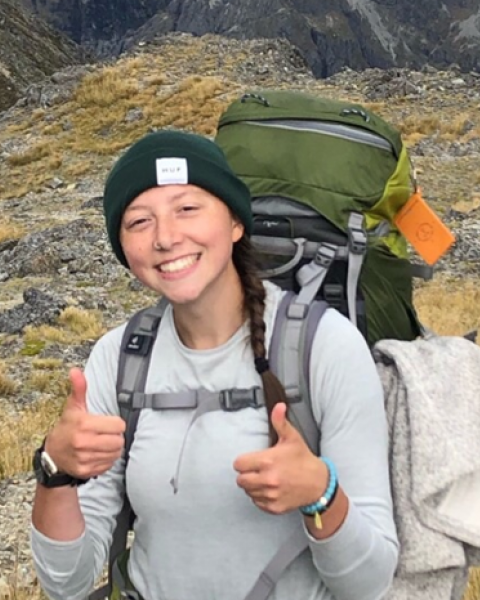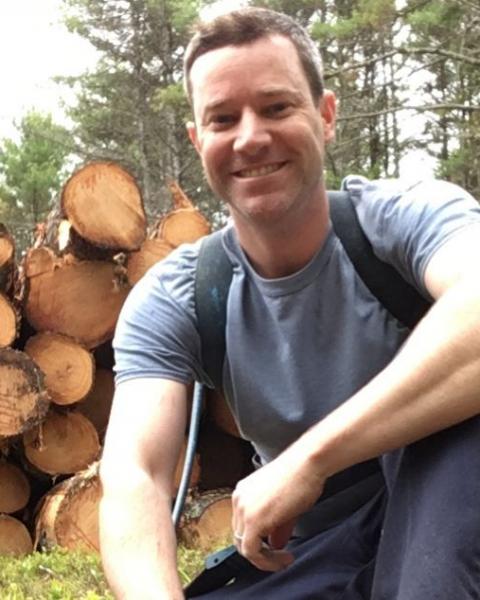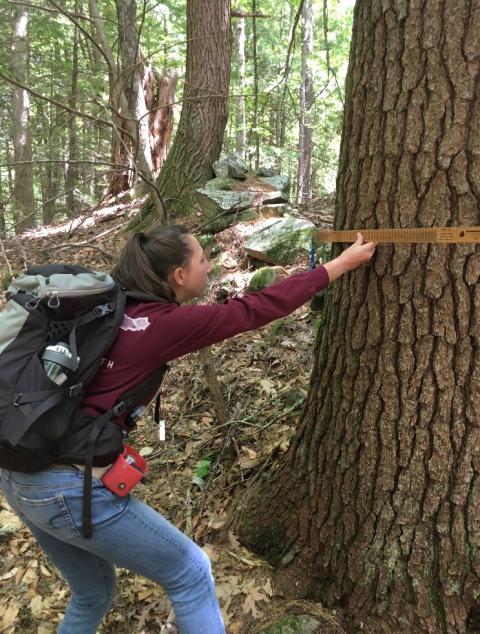
Hello Cooperative Extensive Colleagues and Friends,
It's County Farm Woodlot intern Brooke Gauthier writing to share some of the information and new techniques I have learned so far.
For the past few weeks, Rockingham County Forester Greg Jordan and I have been collecting timber inventory data through prism cruising, or plotless tree sampling method, on the Rockingham County farm woodlot. The forested areas are seperated into four small stands, each about 12 acres.
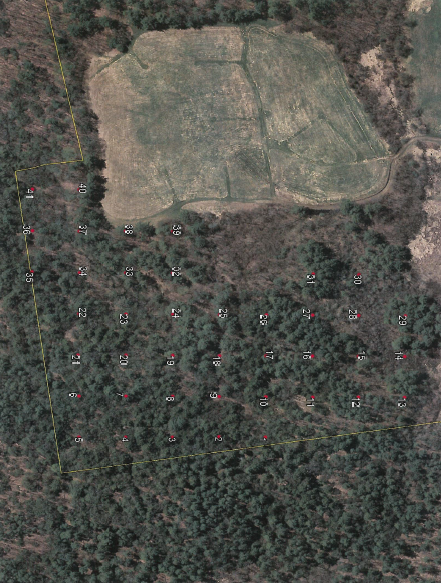
Here is a picture of one of the four stands (a stand is forested area with similar tree species) on the county farm. The yellow line represents the boundary line and the numbered points represent our plot centers.
What is a timber inventory?
A timber inventory (also called a timber cruise) involves measuring a subset of trees on a property in a systematic manner to estimate the value of a timber stand or the possible uses of timber from the land. Statistics from the collected data are total basal area (a measure of how crowded the trees are), number of trees per acres, and overall volume. By collecting this data, foresters can help landowners meet their land management objectives including wildlife potential or give a cutting prescription to keep the land healthy.
The tools we used are a distance-measuring hip chain, flagging tape, Biltmore stick, compass, GPS, 20 BAF (basal area factor) prism and an 80 BAF angle gauge.
Following a compass, our plots were measured 150 feet apart with a hip chain, or a distance-measurer, starting where the edge of the stand and the property boundary meet. Each time we reached the center of a plot, it was recorded on a GPS unit and marked with flagging tape. We used an 80 BAF prism to determine "in" trees. Measurements taken for each "in" tree were tree diameter, number of sawlogs (16 foot logs) and total merchantable height of trees.
Using a 20 BAF prism to pick additional "in" trees, we used our judgement to place these "in” trees into one of four categories—sawtimber, acceptable growing stock, unacceptable growing stock or cavity tree (tree left for wildlife purposes).
All the data we collected was entered into a specific excel sheet for timber cruising designed by Ken Desmarais (formerly forester with N.H. Division of Forests and Lands and now with the U.S. Forest Service) to analyze our measurements.

Me using a Biltmore stick to measure the number of sawlogs and total merchantable height of an individual tree. I paced 66 feet away from the tree, lined the bottom of the Biltmore stick with the bottom of the tree, then used the numbers on the side of the Biltmore stick to help me determine how many sawlogs were in that tree, if any. Things that hinder trees from having a good sawlog are forks in the bole, big or high density of black knots, rot, too small of a diameter, and/or species of tree.
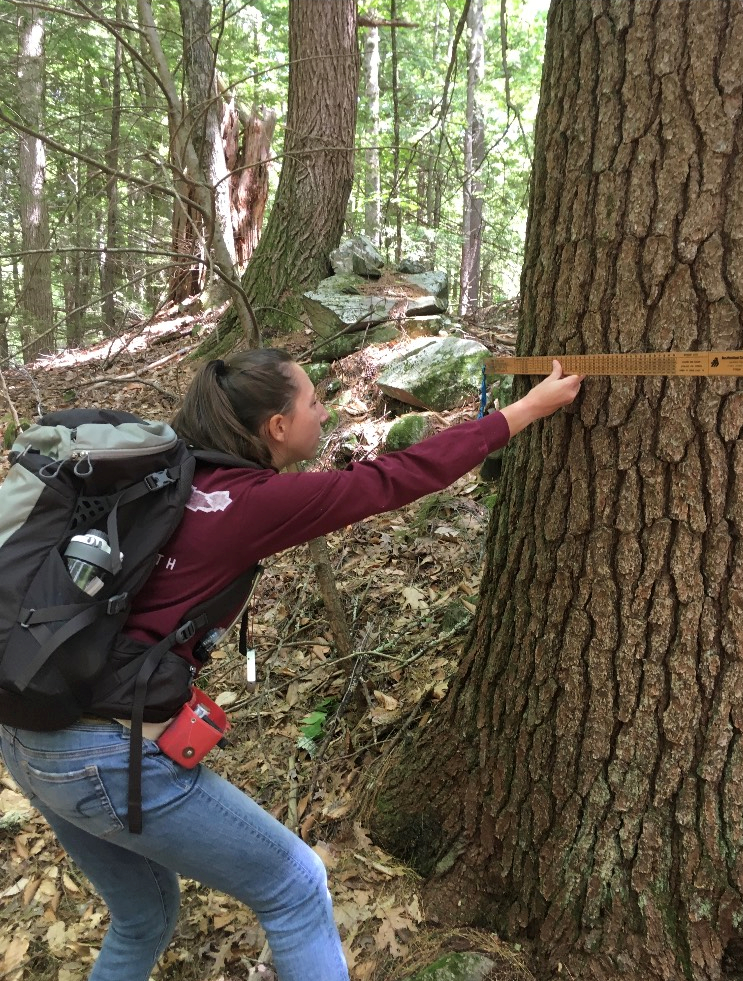
Me measuring the diameter of an eastern white pine using a Biltmore stick. Attached to my waist is a hip chain.
What is BAF?
A basal area factor (BAF) prism is a wedged piece of glass that appears to offset an object, depending on the distance away from the prism. To consider a tree “in” the plot, the displaced bole within the prism has to overlap the actual bole of the tree when the prism user is standing at the plot center. Using BAF prisms allows for plotless sampling because the distance between the plot center and an ‘in” tree can vary greatly based on the bole diameter. Trees with a bigger diameter have a better chance of being considered “in” because the larger bole allows for a tree to be farther from the mid-point of the plot and still have the displaced bole in the prism overlap the actual bole of the tree.
Sometimes, angle gauges can be used to determine whether a tree is in or outside the plot. Angle gauges can be made from every day office supplies, such as a binder clip and string. Using a specific equation, the BAF of choice can be accurately represented by holding the angle gauge a specific distance away from the eye. When holding the gauge the correct distance away from the eye, the tree can be considered "in" the plot if the bole is wider than the angle gauge. If the tree is out of the plot, the angle gauge will be wider than the bole of the tree.

Diagram showing whether a tree should be considered "in" or out when using a prism. This diagram is from Tree and Stand Measurement.

An example of an “in” tree using a 20 BAF prism. The bole within the prism is displaced, but overlaps with the actual bole of the tree.
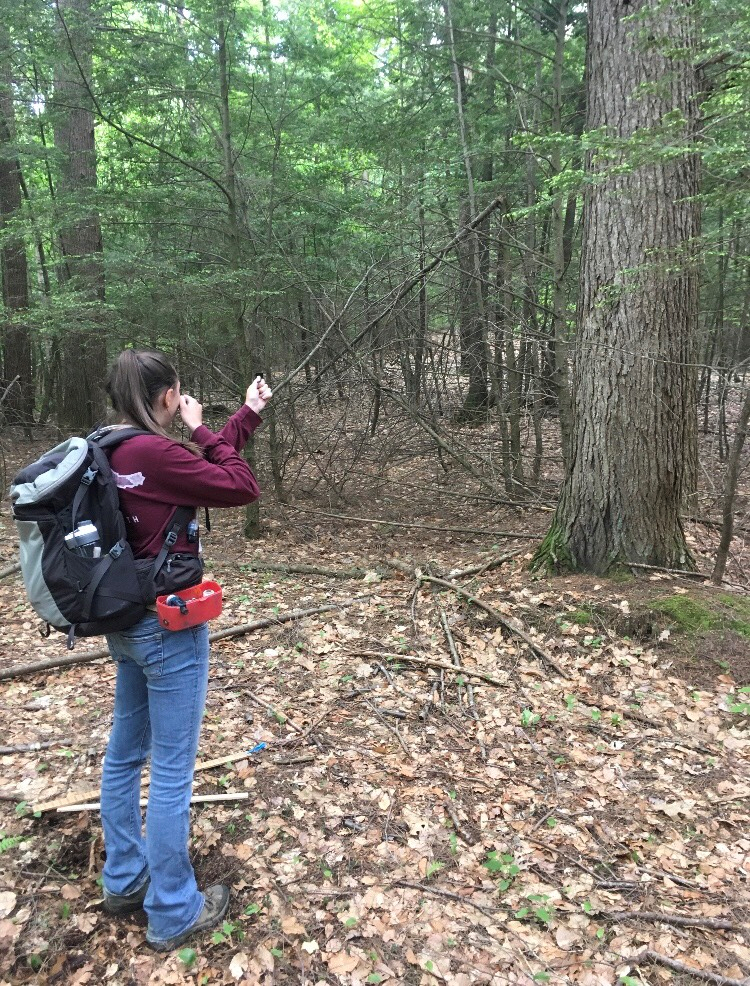
Me using an 80 BAF angle gague made from a binder clip and string to determine if a tree is "in" the plot.
Work vs Class
Prior to this internship, I had some experience in timber inventorying from UNH courses. During labs I used a 20 BAF prism to determine whether a tree is "in" the plot or not. Instead of using a Biltmore stick, I always used a d-tape to measure the diameter of trees. I also used a clinometer to measure tree heights. Seeing the different techniques Greg Jordan uses, especially since he works as a forester, was very intriguing. I have seen Biltmore sticks in class, but never used them to measure diameter or tree height, giving me a broader sense of possible equipement to use when I become a forester.
It is also great being able to compare and contrast the techniques Greg Jordan uses to the techniques I have used in class, both having possitives and negatives. For example, the d-tape gives a better representation of the tree's diameter since it hugs the bark as the tape is wrapped around the asymmetrical bole, but this takes more time. The Biltmore stick is quick and easy because it is simply pressed against one face of the tree, but measurements can be slightly inaccurate to the actual diameter.
Other information
Aside from working with Greg Jordan these past few weeks, I started a vegetation regeneration survey with Merrimack County Forester Tim Fleury. Soon, I will begin marking timber for a harvest with Carroll County Forester Wendy Scribner. Moving forward with my internship, I am very excited to see what other techniques I will learn and what knowledge the foresters will spring upon me.
